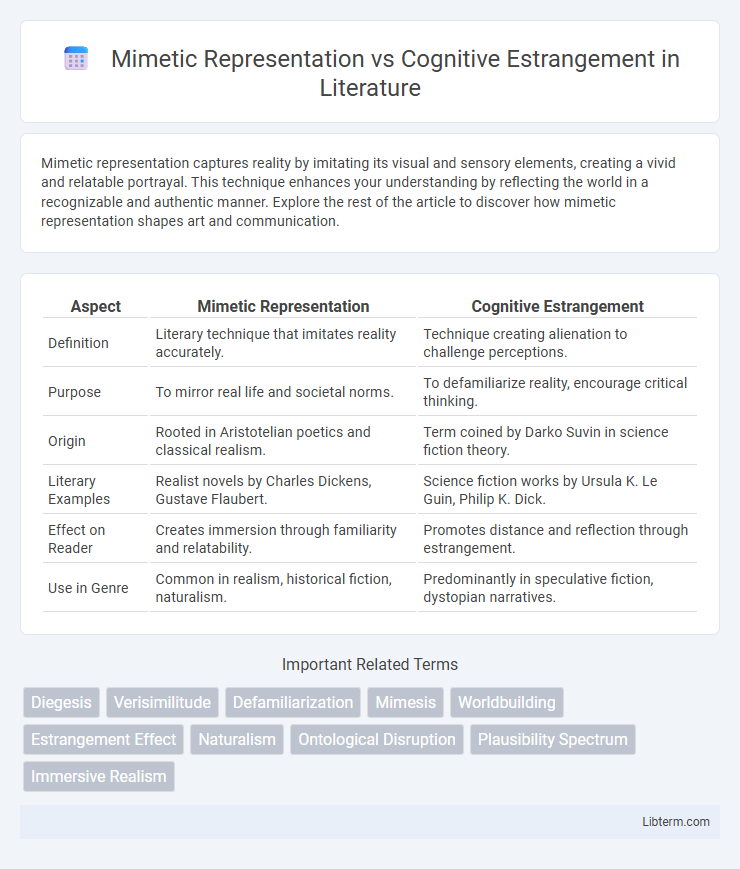Mimetic representation captures reality by imitating its visual and sensory elements, creating a vivid and relatable portrayal. This technique enhances your understanding by reflecting the world in a recognizable and authentic manner. Explore the rest of the article to discover how mimetic representation shapes art and communication.
Table of Comparison
| Aspect | Mimetic Representation | Cognitive Estrangement |
|---|---|---|
| Definition | Literary technique that imitates reality accurately. | Technique creating alienation to challenge perceptions. |
| Purpose | To mirror real life and societal norms. | To defamiliarize reality, encourage critical thinking. |
| Origin | Rooted in Aristotelian poetics and classical realism. | Term coined by Darko Suvin in science fiction theory. |
| Literary Examples | Realist novels by Charles Dickens, Gustave Flaubert. | Science fiction works by Ursula K. Le Guin, Philip K. Dick. |
| Effect on Reader | Creates immersion through familiarity and relatability. | Promotes distance and reflection through estrangement. |
| Use in Genre | Common in realism, historical fiction, naturalism. | Predominantly in speculative fiction, dystopian narratives. |
Introduction to Mimetic Representation and Cognitive Estrangement
Mimetic representation refers to the artistic practice of imitating or closely resembling real-world objects, events, or experiences to create a realistic portrayal that audiences can easily recognize and relate to. Cognitive estrangement, a concept introduced by literary theorist Darko Suvin, involves creating a sense of dislocation or alienation by presenting familiar elements within an unfamiliar or speculative context, prompting critical reflection and new perspectives. Both approaches shape narrative strategies by either reinforcing realism or encouraging intellectual engagement through imaginative distance.
Defining Mimetic Representation
Mimetic representation is the process of depicting reality by closely imitating life-like details, aiming to create a direct and accurate reflection of the physical world. This approach prioritizes realistic portrayal and faithful reproduction of objects, characters, and events as they appear in everyday experiences. In contrast, cognitive estrangement introduces a deliberate deviation from reality to provoke critical thinking and highlight alternative perspectives.
Understanding Cognitive Estrangement
Cognitive estrangement refers to a literary and artistic technique that challenges readers to perceive familiar realities in new and often unsettling ways, fostering critical awareness and reflection. Unlike mimetic representation, which aims to replicate reality accurately, cognitive estrangement intentionally disrupts conventional norms and expectations to provoke a reevaluation of social, cultural, or political constructs. This concept is central to genres such as science fiction and speculative fiction, where alien or futuristic settings encourage audiences to question contemporary issues through a defamiliarized perspective.
Historical Origins and Theoretical Background
Mimetic representation finds its roots in ancient Greek philosophy, particularly Aristotle's theory of mimesis, emphasizing art as the imitation of reality to evoke catharsis or understanding. Cognitive estrangement, coined by Darko Suvin in the 1970s, derives from Marxist and science fiction theory, advocating for a deliberate disruption of familiar perceptions to critique society and prompt critical reflection. Both frameworks offer distinct historical and theoretical lenses: mimetic representation centers on faithful replication of the real world, while cognitive estrangement prioritizes defamiliarization to engage transformative thought.
Key Differences between Mimetic Representation and Cognitive Estrangement
Mimetic representation emphasizes the faithful replication of reality, aiming to mirror the external world through accurate depiction of characters, settings, and events. Cognitive estrangement, rooted in speculative fiction, deliberately alters familiar realities to provoke critical reflection and highlight social or philosophical issues by presenting unfamiliar or distorted scenarios. The primary difference lies in mimetic representation's focus on realistic portrayal versus cognitive estrangement's goal to challenge perceptions and encourage new ways of thinking through imaginative deviation.
Role in Literature and Art
Mimetic representation involves the faithful depiction of reality, aiming to reflect the external world in literature and art with accuracy and detail, anchoring audiences in familiar experiences. Cognitive estrangement, central to speculative fiction and avant-garde art, disrupts the normative perception by presenting altered realities that provoke critical reflection and new perspectives. Both play pivotal roles in shaping audience engagement, with mimesis fostering identification and cognitive estrangement encouraging analytical distance and imaginative exploration.
Mimetic Representation in Realism and Naturalism
Mimetic representation in Realism and Naturalism emphasizes an accurate, detailed depiction of everyday life and social environments, aiming to reflect reality objectively without idealization. It portrays characters and settings with fidelity to empirical observation, highlighting the influence of heredity and environment on human behavior. This approach contrasts with Cognitive Estrangement by grounding narratives in recognizable, plausible experiences that mirror the external world.
Cognitive Estrangement in Science Fiction and Speculative Genres
Cognitive estrangement in science fiction and speculative genres challenges readers to reconsider reality by presenting familiar elements in unfamiliar contexts, provoking critical reflection on societal norms and future possibilities. This narrative strategy contrasts with mimetic representation, which imitates reality closely, by creating a distance that encourages analytical engagement rather than passive acceptance. Prominent works often employ cognitive estrangement to explore complex themes such as technology's impact on identity, speculative ethics, and alternative social structures.
Impact on Audience Perception and Reception
Mimetic representation uses realistic, familiar depictions to create a direct emotional connection, enhancing audience empathy and immersion by mirroring real-world experiences. Cognitive estrangement, by altering or defamiliarizing reality, encourages critical reflection and challenges preconceived notions, fostering a more analytical and often transformative reception. These contrasting approaches shape audience perception by either reinforcing shared truths or provoking thoughtful scrutiny, influencing emotional engagement and interpretive depth.
Conclusion: Comparative Analysis and Future Directions
Mimetic representation emphasizes accurate, lifelike depictions reflecting reality, while cognitive estrangement disrupts familiar perceptions to provoke critical reflection and new understanding. Comparative analysis reveals that mimetic techniques foster emotional resonance through authenticity, whereas cognitive estrangement leverages defamiliarization to challenge assumptions and encourage intellectual engagement. Future directions involve integrating these approaches in multimedia storytelling and virtual reality to balance immersive realism with thought-provoking dissonance, enhancing audience interpretation and critical awareness.
Mimetic Representation Infographic

 libterm.com
libterm.com